| Solar eclipse of June 29, 1927 | |
|---|---|
 Map | |
| Type of eclipse | |
| Nature | Total |
| Gamma | 0.8163 |
| Magnitude | 1.0128 |
| Maximum eclipse | |
| Duration | 50 sec (0 m 50 s) |
| Coordinates | 78°06′N 73°48′E / 78.1°N 73.8°E |
| Max. width of band | 77 km (48 mi) |
| Times (UTC) | |
| Greatest eclipse | 6:23:27 |
| References | |
| Saros | 145 (17 of 77) |
| Catalog # (SE5000) | 9344 |
A total solar eclipse occurred on June 29, 1927. A solar eclipse occurs when the Moon passes between Earth and the Sun, thereby totally or partly obscuring the image of the Sun for a viewer on Earth. A total solar eclipse occurs when the Moon's apparent diameter is larger than the Sun's, blocking all direct sunlight, turning day into darkness. Totality occurs in a narrow path across Earth's surface, with the partial solar eclipse visible over a surrounding region thousands of kilometres wide. The path of totality crossed far northern Europe and Asia, including the United Kingdom, Norway, Sweden, Finland and Soviet Union (today's Russia) on June 29 (Wednesday), and finally passed Amukta in Alaska on June 28 (Tuesday).
Observation in England
This was the first total eclipse visible from British mainland soil for 203 years. The Astronomer Royal set up a camp to observe the eclipse from the grounnds of Giggleswick School in North Yorkshire, which was on the line of totality.[1][2] An observer at Southport, where an estimated quarter of a million people were on the shore to watch, described the eclipse for the Journal of the Royal Astronomical Society of Canada, describing it as "those memorable 23 seconds ... a landmark forever in the lives of those privileged to see for the first time the Sun's Corona, whose secrets are only revealed to us for some few minutes in each century."[3]
This eclipse is referenced in the closing pages of Dorothy L. Sayers' novel Unnatural Death.[4] Frances Brody's 2017 novel Death in the Stars is set at Giggleswick School while crowds were there to view the eclipse.[5]
Virginia Woolf recorded her impression of the eclipse, including the words "We had fallen. It was extinct. There was no colour. The earth was dead."[6]
Related eclipses
Solar eclipses 1924–1928
This eclipse is a member of a semester series. An eclipse in a semester series of solar eclipses repeats approximately every 177 days and 4 hours (a semester) at alternating nodes of the Moon's orbit.[7]
| Solar eclipse series sets from 1924–1928 | ||||
|---|---|---|---|---|
| Ascending node | Descending node | |||
| 115 | July 31, 1924 Partial |
120 | January 24, 1925 Total | |
| 125 | July 20, 1925 Annular |
130 | January 14, 1926 Total | |
| 135 | July 9, 1926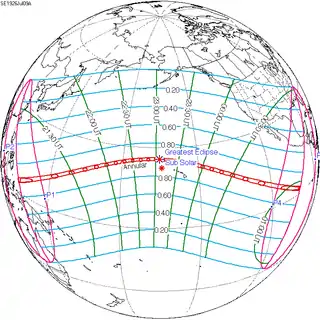 Annular |
140 | January 3, 1927 Annular | |
| 145 | June 29, 1927 Total |
150 | December 24, 1927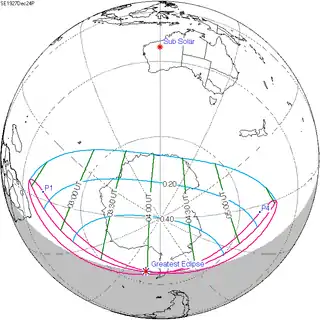 Partial | |
| 155 | June 17, 1928 Partial | |||
Saros 145
This solar eclipse is a part of Saros cycle 145, repeating every 18 years, 11 days, 8 hours, containing 77 events. The series started with a partial solar eclipse on January 4, 1639, and reached a first annular eclipse on June 6, 1891. It was a hybrid event on June 17, 1909, and total eclipses from June 29, 1927, through September 9, 2648. The series ends at member 77 as a partial eclipse on April 17, 3009. The longest eclipse will occur on June 25, 2522, with a maximum duration of totality of 7 minutes, 12 seconds. All eclipses in this series occurs at the Moon's ascending node.
| Series members 10–32 occur between 1801 and 2359 | ||
|---|---|---|
| 10 | 11 | 12 |
 April 13, 1801 |
 April 24, 1819 |
 May 4, 1837 |
| 13 | 14 | 15 |
 May 16, 1855 |
 May 26, 1873 |
 June 6, 1891 |
| 16 | 17 | 18 |
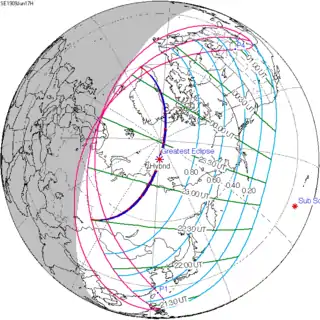 June 17, 1909 |
 June 29, 1927 |
 July 9, 1945 |
| 19 | 20 | 21 |
 July 20, 1963 |
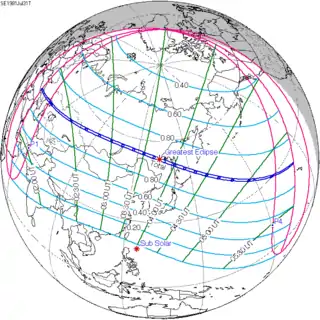 July 31, 1981 |
 August 11, 1999 |
| 22 | 23 | 24 |
 August 21, 2017 |
 September 2, 2035 |
 September 12, 2053 |
| 25 | 26 | 27 |
 September 23, 2071 |
 October 4, 2089 |
 October 16, 2107 |
| 28 | 29 | 30 |
 October 26, 2125 |
 November 7, 2143 |
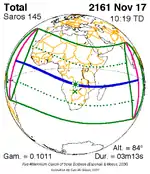 November 17, 2161 |
| 31 | 32 | 33 |
 November 28, 2179 |
 December 9, 2197 |
 December 21, 2215 |
| 34 | 35 | 36 |
 December 31, 2233 |
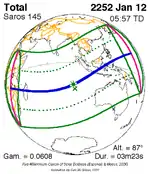 January 12, 2252 |
 January 22, 2270 |
| 37 | 38 | 39 |
 February 2, 2288 |
 February 14, 2306 |
 February 25, 2324 |
| 40 | ||
 March 8, 2342 | ||
See also
References
- ↑ "With the Astronomer Royal". The Guardian. 30 June 1927. Retrieved 9 January 2023.
- ↑ "Eclipse archive". news.bbc.co.uk. BBC News. 17 August 1999. Retrieved 9 January 2023.
- ↑ Seeley, Sylvia (1927). "The total eclipse of June 29, 1927 as seen by a spectator at Southport, England". Journal of the Royal Astronomical Society of Canada. 21: 328-332. Bibcode:1927JRASC..21..328S. Retrieved 9 January 2023 – via SAO/NASA Astrophysics Data System (ADS).
- ↑ "Unnatural Death".
- ↑ "Death in the Stars: the ninth Kate Shackleton mystery by Frances Brody". frances-brody.com. Retrieved 9 January 2023.
- ↑ Popova, Maria (9 May 2018). "Darkness in the Celestial Lighthouse: Virginia Woolf's Arresting 1927 Account of a Total Solar Eclipse". The Marginalian. Retrieved 9 January 2023.
- ↑ van Gent, R.H. "Solar- and Lunar-Eclipse Predictions from Antiquity to the Present". A Catalogue of Eclipse Cycles. Utrecht University. Retrieved 6 October 2018.
Sources
External links
- Recording the eclipse video of the Astronomer Royal's preparations, from Pathé News
.jpg.webp)

